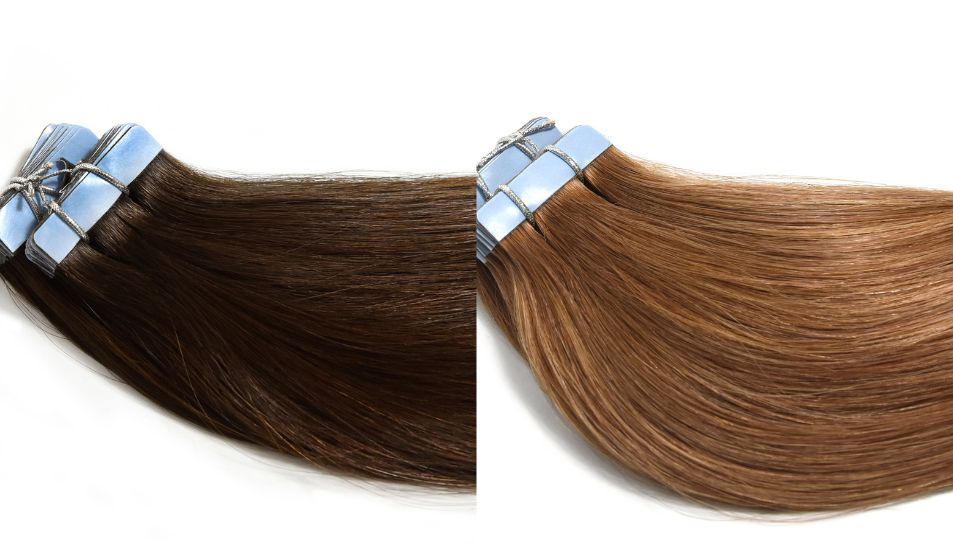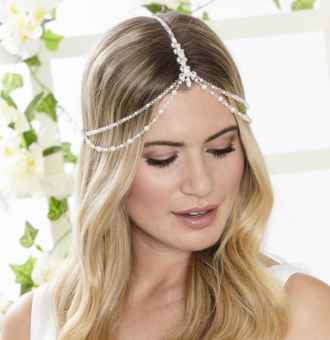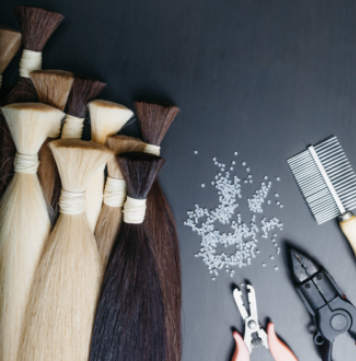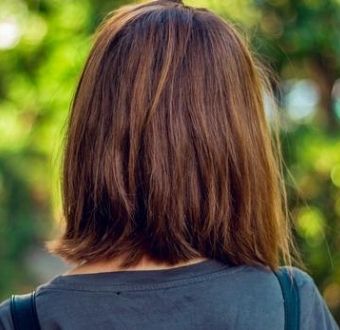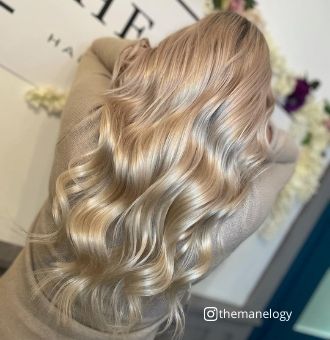Your Cart is empty

on today's blog:
Do Hair Extensions Damage your Hair?
+ Index (click to open)
Do hair extensions ruin your hair? A question that has been asked for years and will continue to be asked for many more. The truth is, there is no clear-cut way to answer to this question, with it comes a whole load of ifs and buts. When used incorrectly, any product applied to your hair can wreak havoc on the way it looks and feels. The importance of research, and sound advice before making such a commitment is vital to achieve the safest, top-quality results.
That is why at Cliphair we strive to give our customers as much honest information as possible, whether that is through our FREE advice service run by extension experts or in the detailed descriptions you will find on our product pages. Choosing the best type of hair extensions for you and correctly caring for them is critical to ensure no damage is caused to your own hair and you will find everything you need to know on this subject right here in todays blog! From temporary to permanent hair extensions and everything in between, we’ve explained the risks, how to choose your type and how to use them properly allowing you to start your hair extensions journey with confidence. We also cover the least damaging hair extensions and how to avoid common mistakes that can harm your hair. (Also read our guide on managing damaged hair)
Types of Hair Extensions

There are many different types of hair extensions, designed and crafted to cater to the needs of a vast public. When it comes to something so personal and unique such as hair types, colours, density, and personal style, there's no "one size fits all" solution! And that's why Cliphair has been working non-stop to offer their stunning hair extensions in different options, so that everyone can find their perfect match.
We have divided this expert guide into 2 categories: Temporary Hair Extensions and Permanent Hair Extensions.
Temporary Hair Extensions include Clip-Ins and Hair Pieces like Ponytails and Fringes. This type of hair extension can be applied and removed easily by yourself, without the help of a professional and tends to have a longer life span due to its occasional use.
The next category is Permanent Hair Extensions which will include Hair wefts, Tapes, Nanos, and I-tips. Permanent, or sometimes referred to as Semi-Permanent Hair extensions are attached to the hair for several weeks before removing and repositioning, this type of extension must be applied by a professional extensionist and is perfect for customers who do not feel comfortable applying their own hair.Whilst permanent hair extensions usually give a far more natural result and come up trumps convenience wise, they also pose a higher risk to the hair if applied incorrectly.
Temporary Hair Extensions

"Do Clip-Ins or Hair Pieces damage your hair?"
Damage is only caused to our natural hair by Clip-in Hair extensions or Hair Pieces when an incorrect weight is used on the hair or from misuse of the extensions. For instance, when a heavy piece or set is attached to very fine or thin hair this can create a lot of tug on your natural hair eventually causing breakage as the hair it is attached too is not strong enough to hold it. This is the biggest cause of hair damage throughout all types of hair extensions and ironically it Is also the most avoidable. Misuse can also play a huge part in causing damage, there are some golden rules that must always be followed when using any temporary hair extensions which we have listed below.
Cliphair's clip in hair extensions all feature metal clips that are silicone-lined on the inside, for maximum comfort and gentle application.
How to choose the correct Clip-Ins for your hair type?
Choosing the right set of Clip-ins or hair piece for your hair type will not only prevent damage to your hair but it will also give you a much better result! Were going to give you some quick tips for understanding the weight of hair extensions and what type is better for your hair thickness. For a more in-depth guide in choosing your hair extensions, take a look at “Which hair extension types are best for Thin/Fine hair?” and “Which hair extension types are best for Medium-Thick hair?”
What Clip-Ins are best for thin/fine hair
The majority of hair extension wearers have hair that is on the shorter and thinner side, hence the reason for wanting to add extra volume and length. Making sure you don’t add too much weight to your hair is vital in protecting it from breakage.
When you have thin hair, the maximum amount of weight you want to be adding to your hair is 180g, this weight should also be evenly distributed around the head and not onto one area. You can find Clip-in solutions that have 8 different pieces to position all over the head meaning the weight is balanced and not focused on one place causing too much tension.
For One Piece hair extensions or hair pieces like Ponytails or fringes the maximum weight you should aim for is 80g and for very thin haired customers 50g is best. It good to also bare in mind that heavier hair extensions will also have a larger more noticeable seam which isn’t always as easy to hide in fine hair. Therefore, choosing a more lightweight hair extension is not only better for the health of your fine hair it will also be easier to blend in!
Below we have listed the products in our range here at Cliphair that we advise our customers to use when they have thin or fine hair.
How to use Clip-In hair extensions correctly?
There are a few golden rules that must be followed when using any temporary hair extensions, whether that’s Clip-ins or hair pieces. Sticking to these guidelines will not only prolong the life span of your hair extensions which will save you time and money, it will also help to prevent your own hair from any harm.
Sleeping or showering with this type of extension attached to your hair is a big no-no. If your Clip-Ins or Ponytail piece are still attached while you sleep, with every toss and turn of your head your hair is rubbing against your pillow meaning the clips on your head are also rubbing against your scalp. This can cause serious problems, first being matting. Not only can this cause your hair extensions to matt on the ends which is a pain in itself but worse it can actually entwine your own hair in with the clips on the top of the weft, trying to untangle this could end up leading to loss of your own hair at the root. Showering with the hair attached has the same effect and can cause irritation to the scalp as well as hair loss.
Another way to protect your precious hair is to make sure the amount of hair you are clipping your extensions to is sufficient to hold the weight. It should not feel painful once you have clipped your hair in, if you can feel any extra tugging or tension this usually means the hair is not gripping properly which can cause the set to slip out, sometimes taking your own hair along with it. If the hair does feel uncomfortable, simply remove it and reapply. Giving your root a little backcombing before attaching the clips is a great way to secure the clip to your hair as it creates a nest for the clip to grab too!
If your Clip-ins feel matted or very tangly, its always best to brush them when they are not in your hair as the tugging motion will pull on your own hair too. We recommend brushing your Clip In hair extensions before and after every use and especially before washing them to keep knots at bay.
Overusing your Clip-ins can also be harmful to your hair, especially if you are using a very heavy set. Even for customers who are lucky enough to have super thick, luscious hair this should be considered. Hair extensions that have a weight between 280-320g are not designed for everyday use, they are fantastic for events and occasional use maybe 3-4 times a week however if you would prefer this look everyday you may want to consider using permanent hair extensions.
Permanent Hair Extensions
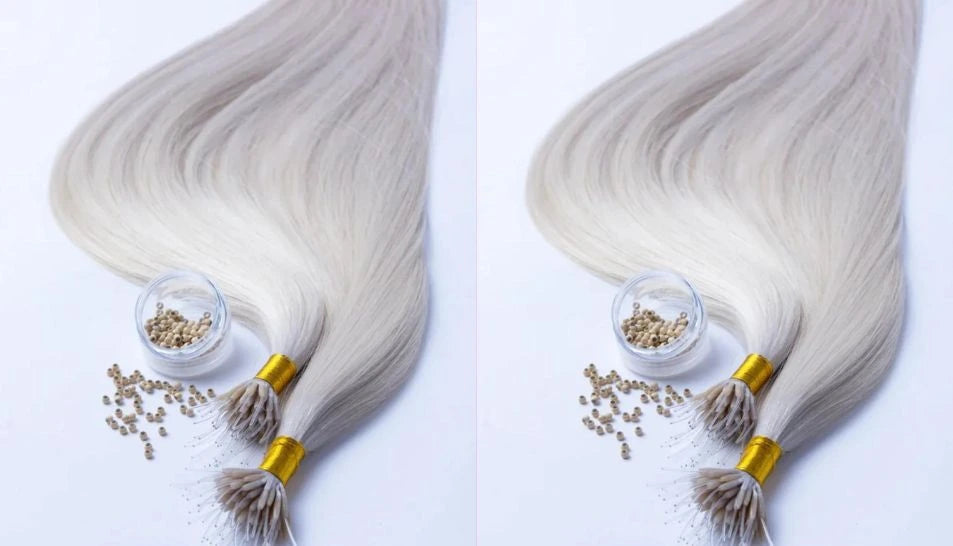
Permanent hair extensions are, by definition, a type of hair extensions that needs professional application and removal, and usually lasts longer than 6 weeks.
This type of hair extensions includes products such as Nano Bond hair extensions. Flat Weft hair extensions, and Invisible Tape hair extensions -- although they are all fitted in very different ways.
Do Pre-bonded, Tape or Weave hair extensions damage your hair?
The major cause of hair damage from professional hair extensions is incorrect application and bad maintenance of the hair extensions in between services. Permanent hair extensions are professional items that should only be applied by a qualified hair extensionist and never on your own hair. Even as a qualified hair extensionist with plenty of years’ experience, I would not be able to perfectly apply my own hair extensions especially at the back of my hair, trust me, I’ve tried and failed! Something so minor like not adding enough hair to your attachment can cause damage therefor we would not suggest attempting self-application however easy it may look.
With the correct care, application and maintenance permanent hair extensions can be life changing for all the right reasons. They tend to have a far more natural appearance as they blend better with natural hair, you have more freedom of where you would like them placed and they are much easier to hide. There is no reason that Permanent hair extensions, when used properly, should cause any damage to your hair.
As this extension type is more of a commitment it’s important to understand that looking after them can be a little more work, you will need to use special products, care regimes and washing/drying can take more time and effort. If this sounds like something you would not be able to commit too, we advise looking into a more temporary option like Clip in extensions. The aftercare care of your Permanent hair extensions is equally as important as the application for protecting your own hair.
To answer the question in short, some deem Tape in hair extensions as the least damaging hair extensions, together with Nano ring hair extensions. The truth is, this can be a very personal statement based on individual experiences at the salon, the type of hair extensions chosen and compared to, the brand used, and so on. These types of hair extensions, for instance, are usually used for different hair types, looks, and situations. Therefore, it would be unfair to compare them.
We strongly recommend having a physical consultation with your stylist before choosing your hair extension type. Your professional will help you pick how much you need, which type to use and will be able to give you a specific plan for how often you need to return for maintenance appointments and how to care for the hair in between. As we have mentioned before, choosing the right type for your hair is half of the work with hair extensions so make sure you get some sound advice before making your decision.
How to choose the correct Permanent hair extensions for your hair type?
We have created a table to show which Permanent hair extensions are suitable for certain for various hair types, then explained below our reasoning.
Hair Wefts/Weaves
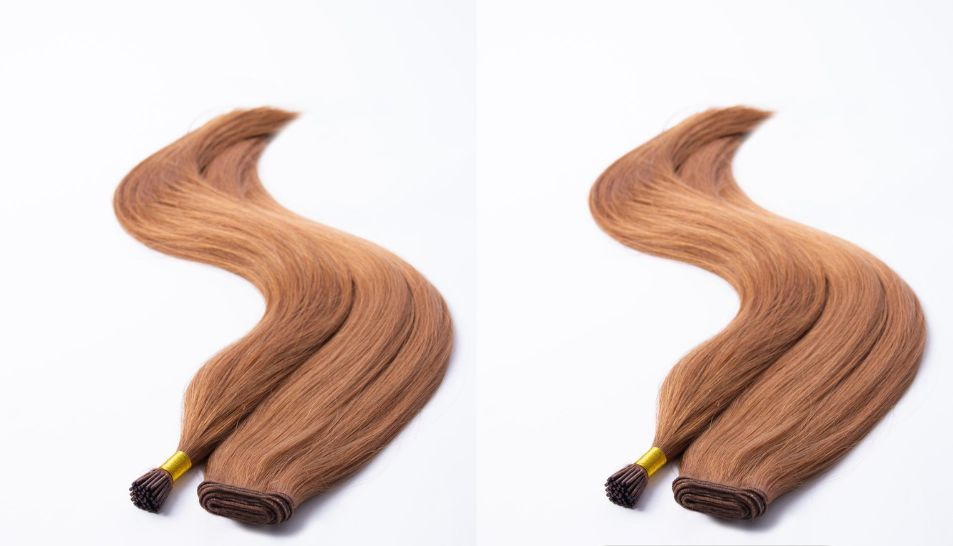
A Hair Weft or Weave as its also referred to is the most versatile hair extension type as it can be used in so many different methods. It can be sewn, weaved, clipped or glued in to create many looks and styles. Its also extremely easy and fast to apply and remove and doesn’t require any heat for the application which is great and far less damaging to the hair.
However, Hair wefts are usually quite bulky, therefore are not usually indicated for fine-haired individuals. For this purpose, the Flat Track Hair Weft was created. Made of a sturdy and much thinner material than the classic lace Weave Weft, the Flat Track Hair Weft hair extensions set caters to a more vast public. Hair Wefts are a fantastic way of adding length to thick hair and are ideal to use when you are transforming a chunky bob into long flowing locks as the thickness of the weft helps to blend out the transition line.
Tape Hair Extensions
Tape in extensions are suitable for all hair types as they are so lightweight and discreet. Unlike Hair wefts, they are not bulky at all and will sit very close to the head making them almost invisible in even the finest of hair. The glue on the sticky tab is made from medical adhesive so it's super gentle and simple to remove with special remover products.
Also available in its luxury, double-drawn format (the Remy Royale Tape in hair extensions), this product is extremely popular due to its versatility and fast application. Those with finer or thinner hair can count on discretion and flexibility of Invisible Tape hair extensions instead: same application, featuring bendy tabs that are completely covered in hair for utmost discretion and a flawless blending.
Our specially formulated Cliphair Tape remover solution is oil-based which is far kinder to the hair and scalp than most alcohol-based removers. Our remover is enriched with citrus oils leaving a soft, fruity scent on the hair rather than a strong chemical odour. Apart from the zero damage factor, the other advantage of using the Tape method is speed. A full head of Tape in hair extensions can be applied to any hair type in under an hour making this a firm favourite in many to hair extension salons!
Nano Ring Hair Extensions
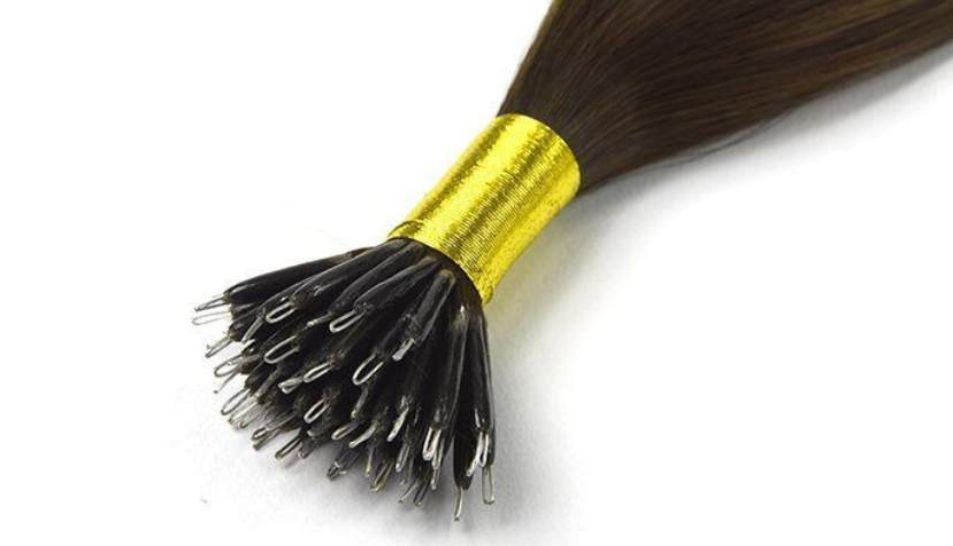
Nano Ring Hair Extensions are the most discreet hair extension method on the market today, so tiny they can even be used to create fringes! They are perfect for thin-haired customers as they can be placed very close to the front hairline without being seen due to their minute size whilst causing zero damage. The reason we would say they are not suitable for thick hair is not because they are harmful but because it would take an age to apply a full head of these to thick hair.
As they are so small this also means they need to be attached to a small amount of hair, creating these tiny sections in thick hair would be very time-consuming. As thick hair is stronger and the risk of damage is less its not necessary to use this method as the same result can be achieved which bigger individual hair extensions such as i-tips or u-tips.
An even more discreet version of the Nano Ring hair extensions would be Nano Bond hair extensions, featuring a see-through silicone tip that blends in finer and lighter hair like never before. A true champion of camouflage, applied following the same method as regular Nanos.
I-Tips/Stick Tips
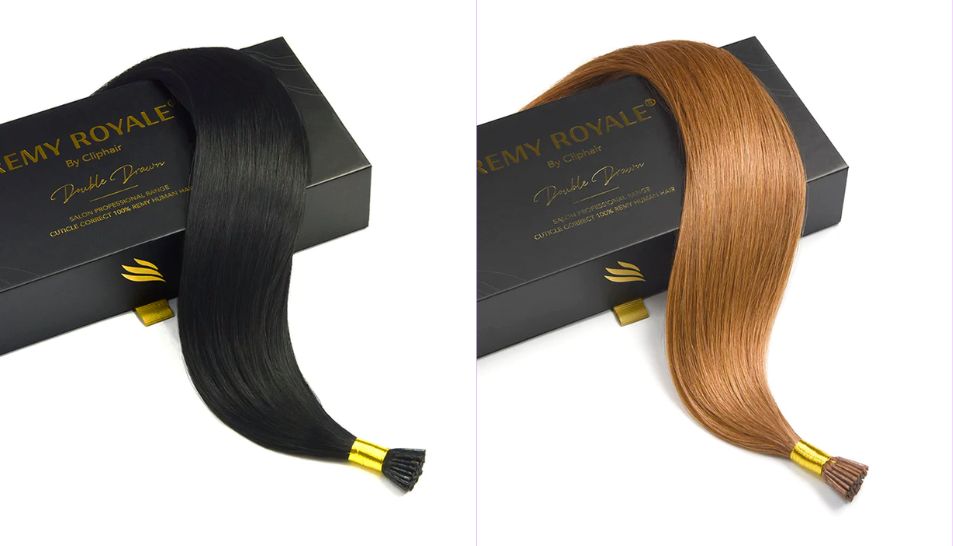
I-tips are a individual, pre-bonded type of permanent hair extension that are attached to the hair with either a copper tube or silicone-lined micro ring. Silicone lined rings are kinder to the hair as they create a barrier between the hair and the metal rings reducing friction. A slightly larger version of the Nano ring method that gives the same effect but can be used on thicker hair as the sections are slightly bigger. This method is great for anyone who has a busy lifestyle and enjoys wearing their hair up as the tips are small and easily hidden.
The latest technology in stick tips has to be Flat Tip hair extensions, featuring a flatter tip that better wraps around its section during application, and heating much quicker.
For very thin-haired customers it may be difficult to hide these extensions, bigger sections need to be taken to hold the weight of the strands. Therefore we advise extremely thin-haired customers to either use Nano Tip Hair Extensions or Tapes as they will not be able to achieve the best results without compromising on either safety or appearance. For fine, average, and thick-haired customers this method is suitable.
Maintenance And Care
The third and final step in protecting your hair from damage is in your hands! After you have chosen your perfect method and had them correctly applied it's now up to you to make sure they are correctly maintained and cared for. Maintenance and re-positioning appointments are essential with permanent hair extensions to keep them looking their best and to prevent any natural hair loss.
On average, humans lose up to 100 hairs a day which is perfectly natural however when you have hair extensions attached these hairs do not fall out completely, they get stuck in the bonds attached to your hair. As your own hair grows your extensions move with it, after 4-8 weeks your extensions will be holding onto less hair as some of your own would have naturally shed, because of this the weight of the attachment will be causing more tension to that area. Having the hair removed and repositioned will allow this natural shedding to fall from the hair and ensure that at no point you are putting too much pressure onto your hair which could eventually cause more hair loss. Leaving the hair in for too long without removing can also cause matting around your roots, which is not only very uncomfortable and time consuming to untangle it could also end up pulling your own hair out in the process.
The good news is, this is totally avoidable by having regular maintenance check ups and well-timed repositioning appointments. There is much confusion between “maintenance” appointments and “re-positions” and we are here to explain the difference.
A maintenance appointment is almost like a check-up. It is a service that should be done no later than 6 weeks after you apply any permanent hair extensions, sooner for first-time users. In this appointment, your stylist will check for any matting and remove it, push up any loose or hanging hair extensions, and replace any that have fallen out. Its also a great excuse to have a thorough hair wash and deep conditioning treatment done seeing as it can be a job to do this on your hair when you have extensions. A re-position and removal are where the hair extensions are completely removed and reapplied using new rings, this service takes longer than a standard maintenance appointment and should also include a full wash and treatment to restore the scalp and hair. We have listed below the time frames and service expectations in a maintenance and reposition appointment for each type as they can vary according to different methods.
Hair Weft – No later than 6 weeks after your application you should return to have your rings re-tight end if you have had the micro-ring weft or LA Weave. New rings should not need to be used in this appointment. If the hair has been sewn in this appointment will simply be to check for matting. No later than 10-12 weeks after your application your weft should be completely removed, washed and repositioned using new rings and braids if necessary.
Tapes – Tape in hair extensions should be removed and either re-taped or replaced with new hair every 4-8 weeks. Despite this, it's never a bad idea to return after a couple of weeks just to check for any matting or irritation especially if it's your first time using them.
Nanos – No later than 6 weeks after your application you should return to have any loose, hanging extensions pushed back up using new rings each time. You will also of lost a few strands by this point so your stylist will put these back in for you whilst also checking and removing any matting at the roots. After 12 weeks you should return for a full removal and reposition of the Nanos, again new rings will need to be used.
I-Tips/Stick Tips – No later than 6 weeks after your application you should return to have any loose, hanging extensions pushed back up you will not need to use new rings as you can simply unclamp and re-clamp as needed. You will also of lost a few strands by this point so your stylist will put these back in for you whilst also checking and removing any matting at the roots. After 12 weeks you should return for a full removal and reposition of the I-tips, new rings will now need to be used.
If at any point in between your services you feel your hair is beginning to matt at the roots you should contact your stylist and make a maintenance appointment, they will also be able to offer advice on prevention of matting in the future.
Use The Best Products For Hair Extensions

In order to make the most of your hair extensions and ensuring they live a long, healthy, and glorious life, you should always resort to products that are specifically designed to care for hair extensions (and natural hair) alike. This is why we always recommend that, when shopping for hair extensions, you also make sure to stop by the Cliphair Hair Care section.
The Quench The Thirst Collection is the main character in this section, featuring moisturising and revitalising products such as their Shampoo and Conditioner for hair extensions -- infused with Baobab seed oil, rice proteins, silk amino acids, and powered by Shea butter.
Last but not least, the Quench The Thirst: Deep Moisture Hair Mask For Hair Extensions is a softening, hydrating, and powerfully revitalising deep conditioning treatment to use on a weekly basis to replenish your hair fibres, pampering your hair extensions and natural hair at the same time. A must-have, tested and trusted by hair experts and salon professionals alike!
So which type of Hair Extensions are least damaging to your hair?
Quick Answer: For temporary Hair Extensions - Clip ins are least damaging
Clip in hair extensions are extremely easy to use (simply clip the clip ins into place and you can easily remove them in a few minutes), they are the most popular option for those looking for instant and temporary hair extensions that cause the least damage to natural hair. In fact, clip in hair extension are perfect for anyone who wants to preserve their own natural hair but like to switch up their look sometimes, or for those who simply wish to grow out their natural hair while still looking glamorous.
Cliphair clip-in hair extensions are designed to not damage your hair at all – the extensions are attached with smooth silicone-coated clips, that stay firm and don’t pull or tug your natural hair.
They won’t scratch your scalp or tangle your roots, and there is no use of glue or heat throughout the process of wearing clip in hair extensions. To make sure you avoid any unnecessary damage, you should select and wear the right weight for your hair (in grams vs the thickness of your hair).
Our hair extensions are shipped worldwide from our headquarters in the UK. Human hair clip in extensions are designed to offer you exact same, professional salon look at a more affordable price. Clip in hair extensions are the least damaging type of hair extension because they’re easy to put in and remove and they don’t affect your lifestyle or your hair as much as permanent extensions. In order for clip in extensions to cause zero damage to your hair, or affect your hair’s growth, it’s important to always use them correctly, like anything else, can be harmful if used incorrectly.
Pay attention to the way you apply your clip in extensions and always make sure you are not adding too much weight to your hair as that will result in the extensions pulling down your natural hair. Wearing hair extensions will not break down the keratin in your hair, however, if they are not applied properly, they strain your hair or if the weight is too much for your hair. T
o clip in your extensions damage free, you must place the clips horizontally from one use of the head to the other, making use they’re clipped in firmly with no chance of pulling or tugging your hair. Ensure that they feel safe and comfortable as correction application is the key to ensuring the extensions and clip in have a natural-looking blend, as well as keeping the hair healthy without causing any unnecessary stress. If you already suffer from brittle hair or hair loss for medical reasons, consult your doctor before buying your clip in hair extensions.
Read more about common mistakes that can damage your hair.
Quick Answer: For permanent hair extensions - Tape ins are least damaging
While clip ins extensions are by far the least damaging type of hair extensions, this is because they aren’t installed permanently and they also offer your hair some rest from too much styling, tape in extensions offer a more natural look and a more seamless blend, as do micro ring extensions.
Tape in hair extensions come with adhesive with double-sided tape that holds the extensions together and attaches the extensions to your hair.
Although we often say glue is bad for your hair, tape in extensions come with a special adhesive designed to be kind to your hair and easy to remove without causing any damage to your hair. It always lays flat on your hair, allowing the extensions to blend them easily with your natural hair. With any of our hair extensions, you should not experience unusual amounts of hair loss.
Tape in extensions don’t affect hair growth in any way at all and cannot help your hair grow at a faster rate than normal. We always encourage our customers to get their hair extensions fitted in by a professional hairstylist as ill fitted tape in will cause damage to your hair. Use of incorrect removal glue may cause the tape bonds not to break properly, which as result, will cause damage as you’ll end up using excessive force to remove the tape in bonds.
So, it is very important to ensure that you use a good quality tape remover. If you look after your extensions and get them fitted and removed properly, tape in extensions won’t damage your hair or cause any problem to your natural hair. You should read the instructions when washing or sleeping in your hair extensions to increase their durability, health and shine.
Tape in extensions won’t cause you any problems if you do things properly. And by that, we mean getting them applied professionally, removed carefully and cared for well while they’re in your hair.
Now your good to go…
So, with a little love and care hair extensions really can be life changing and give you with the hair you have always dreamed of, as long as they are maintained well and chosen correctly there is no reason that they should cause any damage to your hair. Why not have a browse through our collection here Cliphair, our goal is to provide confidence boosting, affordable, gorgeous hair extensions for all, no matter the hair type or concern.
Conclusion
The choice between clip-in and tape-in hair extensions depends on individual preferences, lifestyle, and how long you want the transformation to last. However, you need to pay attention to weight distribution and proper application to avoid potential damage. The key is to have them applied by a professional, follow the recommended hair care routines, and use quality products. Whether you choose the convenience of clip in extensions or the lasting appeal of tape-in extensions, both options highlight the importance of making informed decisions and taking good care of your hair to achieve a glamorous look without damaging your hair health.
Thank you for reading our blog! We hope you enjoyed this article – if you liked what you’ve read, share this with your friends and follow us on our Social Media channels to keep up with the latest trends, tips, guides, and more!
Interested In Hair Extensions? Shop The Best Sellers…
For our full range of Hair Extensions including Clip-Ins, Ponytails, Permanent and Many more with over 60 shades to choose from head to our main page. Including our best selling Seamless, Tape In Hair Extensions, and One Piece Hair Extensions.




